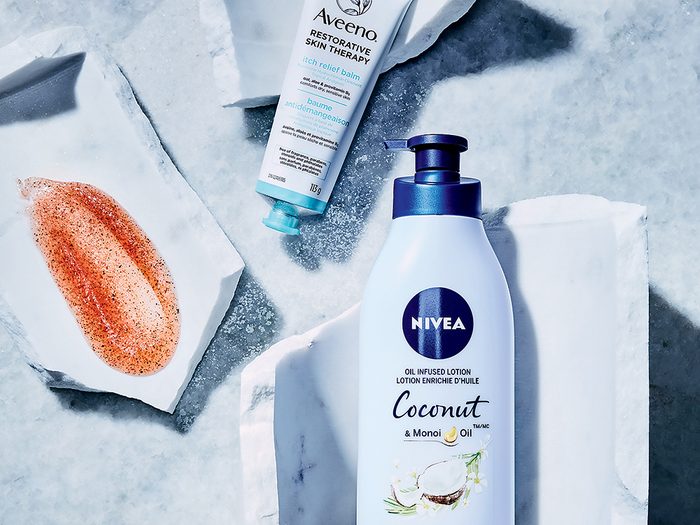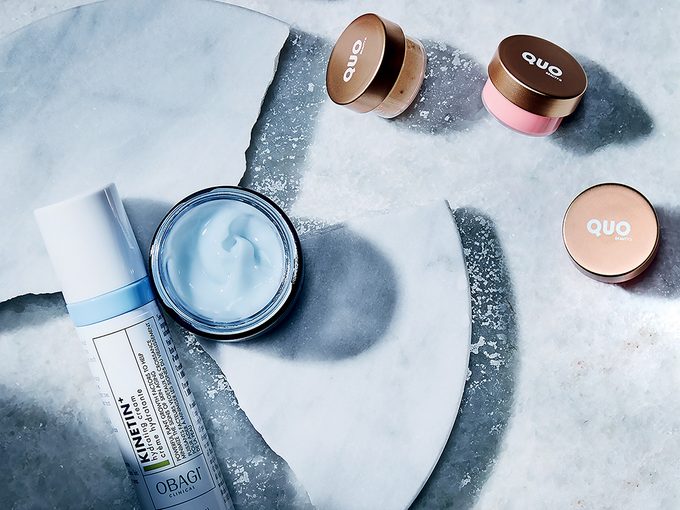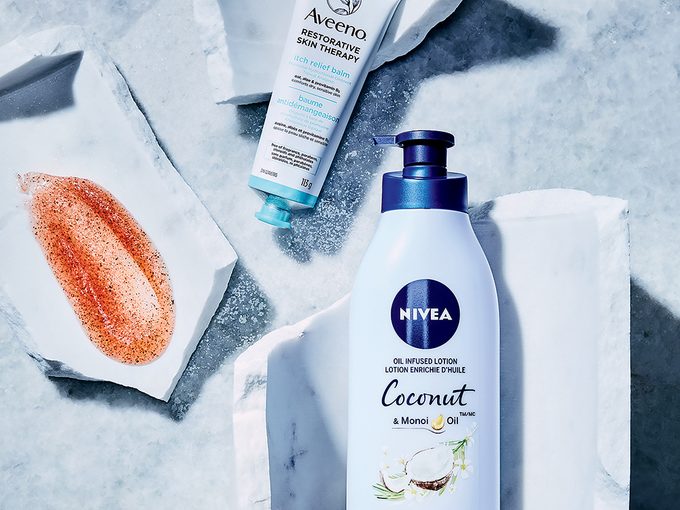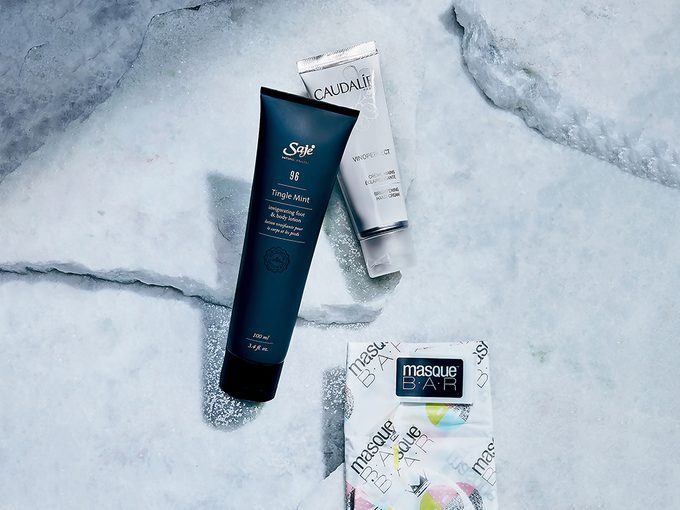The Ultimate Guide to Keeping Your Skin Smooth All Winter Long

In the wintertime, it's all about keeping your skin moist and combatting any dryness.
Cracked lips, chapped cheeks and rough feet are just a few signs that dry skin season is here. First there are the bitter temperatures outside, and then there’s the warm, dry heat inside — and these days, we’re all inside more than ever.
“A major factor that contributes to dry skin is indoor heating,” says Dr. Elyse Love, a dermatologist in New York City. “It is true that the humidity outside is generally lower in the winter than it is in the summer, but the biggest thing is that we spend significantly more time inside, and most heaters blow out dry heat,” she says. “This makes a dry, warm environment that feels very cozy but strips your skin of its normal moisture.”
Fortunately, the right routine — combined with the ideal products for the season — can keep your skin soft and hydrated from head to toe until spring.
(Related: Here’s What Sugar Does to Your Skin)
For your face
Some classic signs of a dry complexion include the telltale tight feeling across the cheeks and a few flakes close to the hairline. But dryness can even result in more pronounced lines around the eyes. “Dry skin can manifest as crow’s feet, but the issue really isn’t deep-set wrinkles, but dryness — a lack of oil and water in the hydrolipidic barrier,” says Liz Kwitman, vice-president of education for French skin-care brand Caudalie. “Once it starts to look dehydrated, you’re significantly aging your skin,” she says.
Change up your cleanser
To get moisture back, start by swapping foaming or gel face washes, which are meant to strip away excess oil (making them ideal for use in the summertime), for a milky or oil-based cleanser. If you’re a fan of toner, ensure it’s alcohol-free and loaded with soothing and hydrating ingredients like glycerine and natural oils.
Add a serum
Whether your skin-care regimen is minimal or a multi-step ritual, smoothing a serum over your face and neck should be next in your routine. “A serum is non-negotiable,” says Kwitman. Serums are able to penetrate deeper than creams to target specific skin concerns. If dryness is your main issue these days, opt for a serum with hyaluronic acid and peptides to lock in hydration.
If you use an anti-aging serum containing active ingredients like retinol or glycolic acid (which boost skin cell turnover), you might have to apply it less frequently during the colder months, says Love. If you’re suddenly experiencing tightness or noticing red patches, cut back to every other night instead of nightly, for example, or switch to a product with a lower concentration. “In general, your skin is a lot more sensitive in the winter, especially if you’re using active ingredients,” she says.
(Related: 8 Signs Your Skin Products Are Secretly Damaging Your Face)
Seal in moisture
You’ll need to rethink your day cream too, and level up to a product that has a heavier texture to help your skin seal in moisture. Humectants like ceramides and glycerine pull moisture into the skin and create a protective barrier.
If you swap your warm-weather day cream for a winter-friendly product, make sure you still include an SPF in your routine. “We know that chronic sun damage happens even in the winter — sun protection is important year-round,” says Love. That’s why she recommends using a sunscreen that’s separate from your moisturizer. Apply it after your day cream, before your makeup, to shield your skin from UV damage.
Try a sleep mask
Another secret to keeping dryness at bay is to give your complexion a mega dose of moisture while you sleep. “Overnight sleeping masks can really be helpful for locking in moisture,” says Love. Apply one a few times a week in place of your usual nighttime moisturizer. A heavier lip product, or even a lip mask, is also good to try.
(Related: The 8 Best Things to Do to Your Skin in Quarantine, According to a Dermatologist)

Try:
1. Obagi Clinical Kinetin+ Hydrating Cream ($73, sephora.ca). This hard-working hydrating cream is designed to moisturize rough, dry skin.
2. Quo Beauty Triple Treat Lip Prep Trio ($18, shoppersdrugmart.ca). Exfoliate, smooth and say goodbye to desert-like conditions your lips with this deeply hydrating three-step system.
3. Klorane Night Time Hydrating Mask ($38, jeancoutu.com). Apply a thick layer at bedtime to rehydrate and regenerate skin with active ingredients like organic edelweiss.
For your body
Before you notice scales on your elbows or red patches on your thighs — what you may think of as the first signs of dry skin — you’ll likely find yourself scratching your shins or the insides of your arms. “The number one sign of dryness [on the body] is actually itchiness, which can be a bit confusing to people,” says Love.
That’s why dermatologists sometimes refer to eczema, the most extreme form of skin dryness, as “the itch that rashes.” People with atopic dermatitis (a.k.a., eczema) have a compromised skin barrier, which is meant to protect the body from irritants, bacteria and allergens. This leaves them vulnerable to the effects of environmental stressors, including cold temperatures, dry air and even hot water.
A soak in a steaming tub is a big no-no for someone with eczema, but it’s not recommended for the rest of us during peak cold season, either. While a hot shower might feel amazing on a chilly winter morning, it’s actually drying out your skin. Love suggests restricting bathing to no more than 10 minutes in lukewarm water.
(Related: Do Cold Showers Have Health Benefits?)
Swap your soap
To make your shower more moisturizing, swap soap and gel wash for a body-cleansing oil with plant oils to nourish your skin. And don’t forget to buff away rough spots a few times a week with a gentle face and body exfoliant. Then, for maximum skin hydration, moisturize from head to toe within three minutes of towelling off with a thick body balm that contains silicone, lanolin or plant oils.
Break out the humidifier
“For patients who are particularly prone to dry skin, I always recommend running a humidifier,” says Love. Flick it on in your home office during the day and then move it to the bedroom at night. “It puts some of that moisture back into the environment, so it’s not being stripped from your skin,” she says. (Just be sure to keep it clean, since a humidifier can be a breeding ground for bacteria. Wipe the base dry daily, and clean it out weekly with a vinegar-and-water solution to get rid of any traces of mould and mineral buildup.)
(Related: 10 Everyday Habits That Are Drying Out Your Skin)

Try:
Aveeno Restorative Skin Therapy Itch Relief Balm ($10, walmart.ca). This high-performance balm contains a topical analgesic, along with oats, aloe and provitamin B5 to target and treat irritated, itchy, dry skin.
Soap & Glory Scrub for Joy Body Polish ($18, shoppersdrugmart.ca). Walnut shell powder helps buff away dead skin cells, dirt and impurities, leaving behind softer, smoother skin. It’s perfect for notoriously rough knees, elbows and heels.
Nivea Oil Infused Coconut & Monoi Oil Lotion ($12, well.ca). Use this non-greasy, fast-absorbing moisturizer from the neck down for all-day hydration.
For your hands and feet
Hands are definitely going to need some TLC this season, with all the extra washing and sanitizing we’re doing these days. “Hand dermatitis was already on the rise in the spring, so it’s definitely going to be a problem for a lot of people this winter,” says Love.
Keep hand cream… handy
To help prevent rough spots and cracking across your knuckles and on the tips of your thumbs, keep a lightweight hand cream beside the sink so you can moisturize throughout the day, immediately after washing. Like body lotions, nourishing hand and foot creams contain humectants and emollients that draw moisture to the skin and lock it in.
Get a good foot cream
The skin on your feet is thick and can build up calloused layers of dry skin. A foot cream that contains lactic acid or urea can be helpful for sloughing off really rough spots. Apply it in the morning before you slip on your socks and then again when you tuck in for the night. (Particularly parched hands could also use an extra-thick layer at night.)
“Covering up with cotton socks and gloves will keep the cream in place, and the heat generated will help it penetrate the skin,” says Kwitman. If you can’t sleep with socks and gloves on, turn this moisturizing routine into an evening TV ritual a few times a week.
(Related: 14 Weird Things That Happen to Your Body in the Winter)

Try:
Caudalie Vinoperfect Brightening Hand Cream ($26, caudalie.ca). This rich, non-greasy hand cream melts into the skin for instant hydration. Plus, it minimizes the look of dark spots and creates a brightening effect.
Saje Tingle Mint Invigorating Foot & Body Lotion ($16, saje.com). Shea butter and peppermint oil invigorate dry, tired feet. Work this minty-fresh lotion up over your ankles and lower legs for a refreshing boost.
Masque Bar Intensive Moisturizing Foot Mask ($10, shoppersdrugmart.ca). This sock-style mask noticeably smooths, softens and repairs cracked, rough feet in just minutes.




